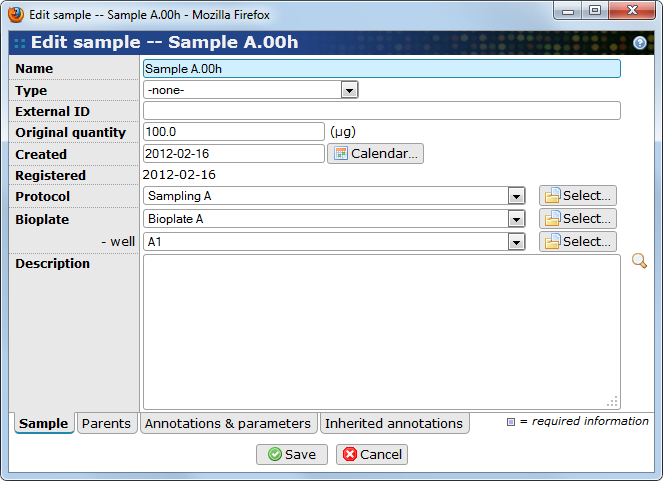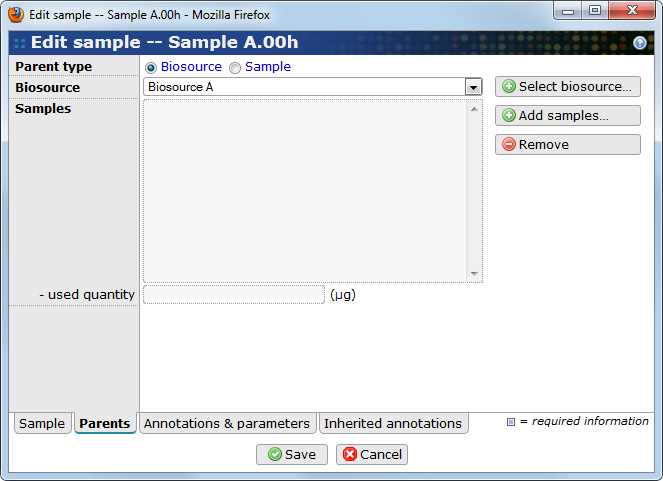Samples result from processing events applied to biosource material or other samples before they are turned into an extract. In other words, samples can be created from biosource items or from one or more sample items. When a sample is created from several other samples, a pooling event is performed.
For every step of transformation from biosource to sample, it is possible to provide information about the protocol used to perform this task. It is not enforced in BASE but it should serve as guidance when devising the granularity of the sample processing task. Also, it is good practice to provide protocol information to ensure MIAME compliance.
Use to get to the list of samples.
Beside the common way, using the button, a sample can be created in one of the following ways:
- from either biosource list- or single view- page.
-
No matter how complex the sample processing phase is, at least one sample has to be anchored to a biosource. Therefore, a natural way to create an sample is to click on
 in the Samples column of the biosource list view. There is also a
corresponding button,
in the toolbar when viewing a single biosource.
in the Samples column of the biosource list view. There is also a
corresponding button,
in the toolbar when viewing a single biosource.
- from the sample list page
-
Child samples can be created from a single parent by clicking on the
 icon in the Child samples column.
Pooled samples can be created by first selecting the parents
from the list of samples and then click the
button in the toolbar.
icon in the Child samples column.
Pooled samples can be created by first selecting the parents
from the list of samples and then click the
button in the toolbar.
- Name
-
The sample's name (required). BASE by default assigns names to samples (by suffixing
s#when creating a sample from an existing biosource orNew Sampleotherwise) but it is possible to edit at will. - Type
-
The subtype of the sample. The list may evolve depending on additions by the server administrator. Selecting the proper subtype is recommended and enables BASE to automatically guess the most likely subtype when creating child biomaterial. See Chapter 12, Item subtypes and categories for more information.
- External ID
-
An identification used to identify the sample outside BASE.
- Original quantity
-
This is meant to report information about the actual mass of sample created.
- Created
-
A date when the sample was created. The information can be important when running quality controls on data and account for potential confounding factor (e.g. day effect).
- Registered
-
The date at which the sample was entered in BASE.
- Protocol
-
The protocol used to produce this sample.
- Bioplate
-
The bioplate where this sample is located.
- Biowell
-
Biowell that holds this sample. Bioplate has to be defined before biowell can be selected.
- Description
-
A text field to report any information that not can be captured otherwise.
This is meant to keep track of the sample origin. BASE distinguishes between two cases which are controlled by the Parent type radio-button in the edit pop-up window.
-
If the parent is a biosource the radio-button is set to Biosource. Only a single biosource can be used as the parent. This option is automatically selected if the user selects a biosource with the button.
-
When the parent is one or several other samples the radio-button is set to Sample. This option is automatically selected if the user add samples with the button. For each parent sample, it is possible to specify the amount used in µg. This will automatically update the remaining quantity of the parent.
The Annotations tab allows BASE users to use annotation types to refine sample description. More about annotating items can be read in Section 10.2, “Annotating items”
This Inherited annotations tab contains a list of those annotations that are inherited from the sample's parents. Information about working with inherited annotations can be found in Section 10.2.2, “Inheriting annotations from other items”.

